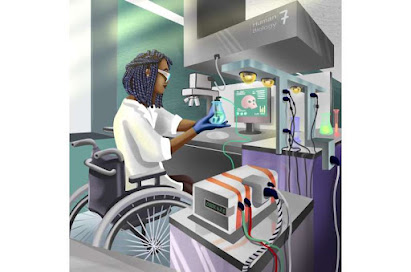Making science more accessible to people with disabilities
The pandemic prompted workplace changes that proved beneficial to people with disabilities in science, technology, engineering, math and medicine (STEMM), but there's fear that these accommodations will be rolled back. With International Day of Persons with Disabilities taking place on Dec. 3, a research team including faculty at Binghamton University, State University of New York is calling for ways to make work in STEMM more accessible.
Listen this article in our podcast.
"We're increasingly hearing about how nice it is to 'all' be together again, as well as calls to put the pandemic behind us and increasingly strident demands for pre-pandemic 'normal,'" said Binghamton University Associate Professor of Anthropology Katherine Wander. "We are worried that lessons learned during the pandemic will be lost."
Wander, along with University of New Mexico Associate Professor of Anthropology Siobhán Mattison and others, outlined the situation and the framework for potential solutions. The paper draws on insights from disabilities studies, an interdisciplinary field of research that explores the ways that disabilities are created by social processes as well as biological ones. Many people within STEMM are unaware of disabilities studies' insights, and can fail to see these social dimensions, the authors said.
The dynamics of exclusion on the basis of disability also overlap with other exclusionary dynamics, such as those based on sex/gender, sexual orientation, race, ethnicity or socioeconomic status. While each type of exclusion has elements in common, they also have their own unique dimensions, the authors acknowledge.
Wander points to the commonalities among experiences of exclusion to consider how they might best be mitigated. Working from home, for example, not only benefits some people with disabilities, but also people from minority racial or ethnic groups, some of whom found that remote work alleviated much of the bias they experienced in the workplace. That being said, not everyone finds remote work accessible, as it depends on decent Internet access, among other factors. In short, there is no single, simple solution that will increase inclusion for any one group.
Instead, the authors advocate an approach based on three pillars: flexibility, accommodation and modification (FAM).
Providing more flexibility in the workplace will expand the contributions of people with disabilities and others who face various constraints, such as the need to provide care for family members. When broad flexibility isn't possible or enough, accommodations should be available to help people achieve their role's core functions. Modification of work duties can also help STEMM retain the insights and efforts of people whose disabilities sometimes or persistently impede their ability to work in positions that are not designed for them.
Adopting FAM strategies, however, involves changing long-standing practices and could involve some financial costs to institutions. However, the benefits to science, students and patients are likely to be substantial, the authors say.
Ultimately, the FAM approach can benefit everyone. While someone may not be considered disabled today, injuries, illness and aging may change their circumstances in the future. The phenomenon of long COVID, the authors point out, reminds us that no one is more than one illness away from lasting disability.
"Inclusion is a proactive responsibility. If we're going to say that everyone deserves a seat at the table, then we have to make sure that places are set for everyone," Mattison said.
Co-authors in addition to Mattison and Wander include Logan Gin of Brown University's Sheridan Center for Teaching and Learning, Allistair Abraham of George Washington University's Department of Pediatrics, Megan Moodie of the Anthropology Department at the University of California—Santa Cruz, and Feranmi Okanlami of the University of Michigan's Family Medicine, Physical Medicine & Rehabilitation program.
The paper, "Community voices: Broadening participation in science, technology, engineering, mathematics, and medicine among persons with disabilities," was published in Nature Communications.
For more such news & interesting articles or how can it affect in your life subscribe to our newsletter


Comments
Post a Comment